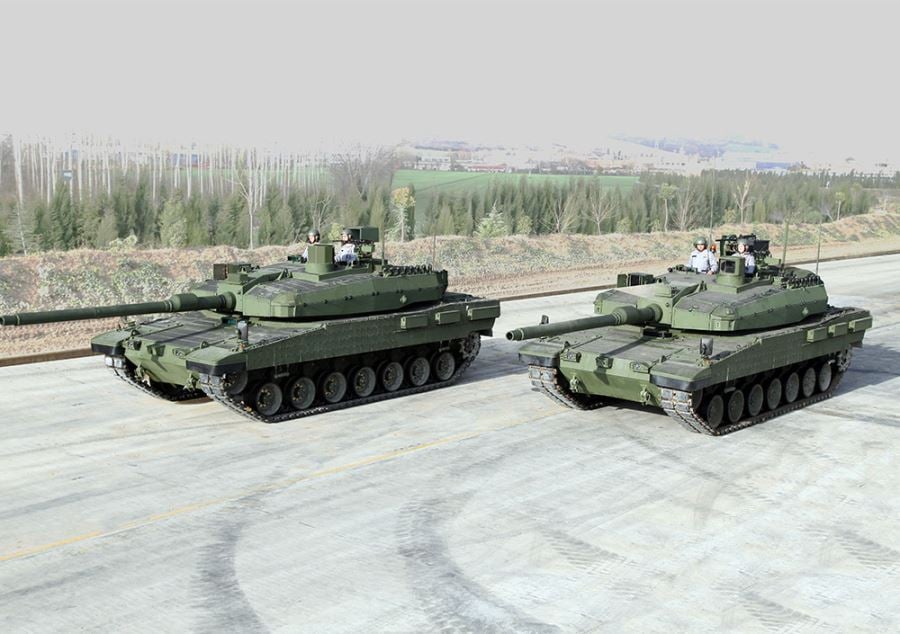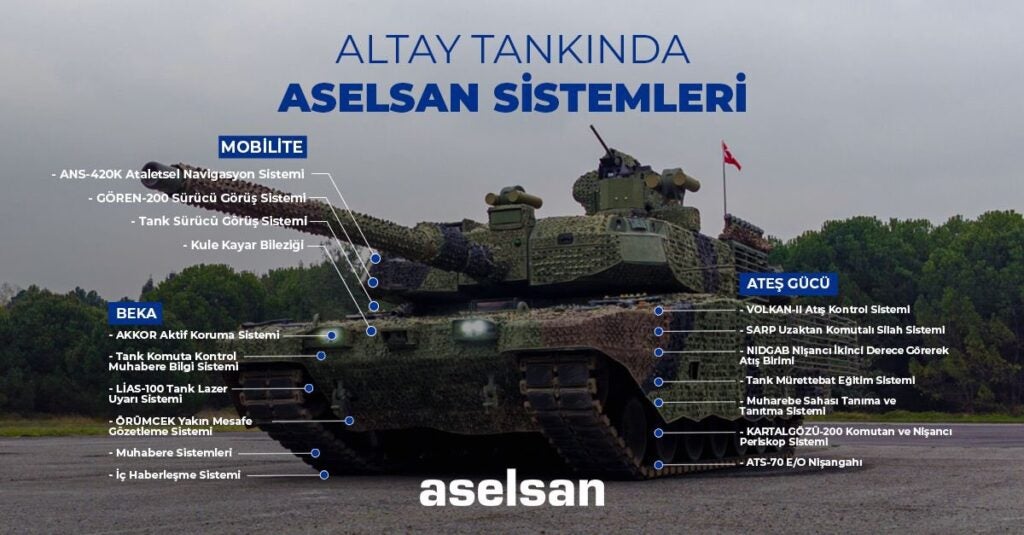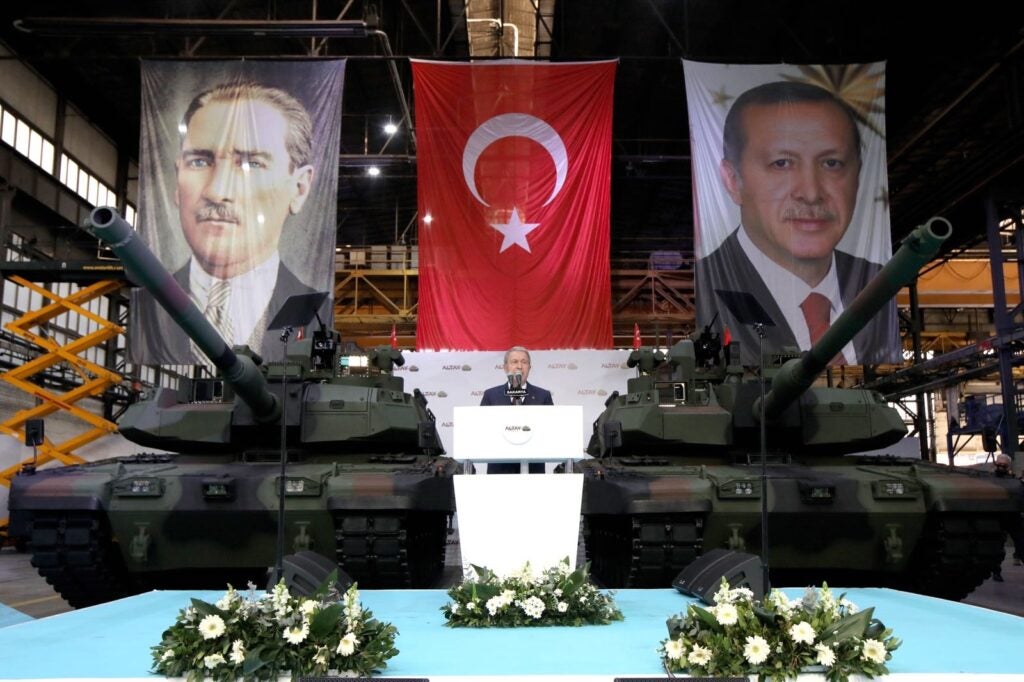The Turkish Armed Forces Receive Two New ALTAY Main Battle Tanks For Testing
Two new ALTAY Tanks produced by BMC Defense under the supervision of the Turkish Defense Industry Agency were delivered to the Turkish Land Forces Command on 23 April. A ceremony held at the company’s Arifiye campus in Sakarya handed over the vehicles for military testing. Turkish President Recep Tayyip Erdoğan, the head of the Turkish Defense Industry Agency İsmail Demir, Turkish Defense Minister Hulusi Akar, Chief of General Staff General Yaşar Güler, Land Forces Commander General Musa Avsever, Naval Forces Commander Admiral Ercüment Tatlıoğlu, and Air Force Commander General Atilla Gülan all attended the ceremony.
President Recep Tayyip Erdoğan stated during his speech at the ceremony that they have been working for many years to meet the demand for ground vehicles of the Turkish Security forces with domestic means, and as a result, he is excited about the delivery of the new tanks. President Erdoğan stated that numerous institutions and organizations have built many vehicles, notably of various types and features, and that the Altay has very different and superior capabilities than the prototype that was initially unveiled ten years ago. Noting that the company will start mass production immediately after the test activities of the tanks in question are completed, Erdoğan said, “I believe that our new Altay tank will serve as a very important force multiplier for our Armed Forces in this region. I congratulate our Ministry of National Defense, our Defense Industry Agency, our Turkish Armed Forces, BMC Defense and everyone who contributed to the project.”
“As someone who knows and has lived through most of the processes Altay went through, I can easily say that this tank is one of the most modern tanks in the world,” said İsmail Demir. “Our tank’s combat capability has been increased by the addition of updated technologies and innovations, and many subsystems that were difficult to procure from abroad have been localized.” Demir stated that the new tank, in which they increased the usage of digital technology, has modern technologies such as a fire control system, a laser rangefinder, and a more sensitive stabilization system. “In this manner, the tank will be able to detect targets at long distances and accurately engage all targets that may be encountered on the battlefield, both while moving and at a standstill, with a high accuracy rate. One of the improvements in our new Altay tanks was the hybrid protection concept we developed using advanced armor modules and the Active Protection System (AKKOR).”
The first contract for the Altay tank was signed in 2008, and within that scope, Otokar developed two prototypes. However, the serial production contract for the Altay project was later awarded to BMC. On November 9, 2018, the Altay Tank Mass Production Contract was signed, and it was reported at the ceremony that serial manufacturing of 250 Altay tanks was planned in the first stage. According to the project’s timeline, the first tank was supposed to be delivered to the Land Forces Command after 18 months. Due to subsystem supply contracts and Turkey’s Peace Spring Operation in northern Syria, German companies MTU and RENK decided to “not approve the export of defense industry products that can be used in Syria” for the tank’s engine and transmission supply. Because of the embargo, there were delivery delays.

Later, Turkish officials struck an agreement with South Korean companies Doosan and S&T Dynamics for the Altay, which could not initially be manufactured owing to a ‘engine problem’, in the fourth quarter of 2021. Within the terms of the negotiated deal, two new Altay tanks, based on the K2, have been delivered to the Turkish Armed Forces for testing were also outfitted with power packs supplied by the Republic of South Korea. According to Demir, the first mass production deliveries will be manufactured with power packs procured from South Korean companies. The tanks in question will eventually be powered by the 1500 horsepower BATU engine, which BMC Power is still testing.
Turkey, which had a difficult time procuring subsystems during this period, has refurbished its ALTAY tank in accordance with the conditions of the modern combat environment, and its name has been updated as the new Altay. This tank, renamed “New ALTAY,” has gained a lot of additional capabilities over the initial prototypes of the original ALTAY tank, and many of its critical subsystems have been refurbished and localized. Ammunition racks, turret ring gear, rotor, flat periscopes, gunner’s auxiliary sight system, manual ignition system, fuel-heating and bilge pumps, hydraulic pumps, road wheels, and cooling vests are among the systems localized in this process.

The Turkish defense company Aselsan supplied the systems grouped under the categories of firepower, protection, and mobility in the new Altay tank, also known as the Iron Triangle. The VOLKAN-II Fire Control System, SARP Remote Controlled Weapon System, NIDGAB Gunner Secondary Sight Firing Unit, Tank Crew Training System, Battlefield Recognition and Identification System, KARTALGÖZÜ-200 Commander and Gunner Periscope System, and ATS-70 E/O Sight are among the systems provided by ASELSAN to the new Altay tank under the firepower category. The tank is outfitted with the ANS-420K Inertial Navigation System, GÖREN-200 Driver Vision System, Tank Driver Vision System, and Turret Slip Ring in the mobility category, and the AKKOR Active Protection System, Tank Command Control Communication Information System, LİAS-100 Tank Laser Warning System, ÖRÜMCEK Close Range Surveillance System, Communication Systems, and Internal Communication Systems in the protection category.
These 3rd generation Altay tanks, which have gained additional features related to the experience gained within the framework of the operations carried out by the Turkish Armed Forces (TAF) in recent years, are expected to enter the inventory of the Turkish Land forces in 2024 or 2025, following the completion of their tests with the Turkish Armed Forces.

